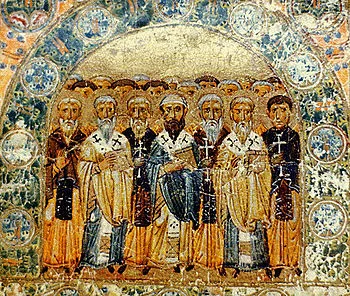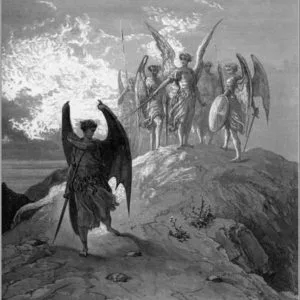Writing in his journal in 1873, Charles Darwin said “I have lately read Morley’s Life of Voltaire and he insists strongly that direct attacks on Christianity (even when written with the wonderful force and vigor of Voltaire) produce little permanent effect; real good seems only to follow the slow and silent side attacks.” Using his slow and silent theory of Evolution as his side attack, Darwin decided that he would reimagine the Book of Genesis. The original Origin of Species speaks of the supernatural beginnings of all of creation and it was to be replaced by a completely naturalistic explanation for the origin of all that is. Darwin’s Theory of Evolution started a revolution, first by consigning the first three chapters of Genesis to “myth” and then systematically deconstructing each of the tenets of the Creed. The Church was certainly caught flat-footed when the attack began and the Faithful made compromises with Darwinists that can be labeled as “theistic evolution.” But this compromise does not just remake the beginnings but removes the supernatural from nearly every element of the Faith. It is high time then that we reconstruct a theology of Creation which starts with a proper understanding of the opening chapters of Genesis.
Before diving into the specifics, we must first admit that the use of figurative language has as its goal to make the truth clearer. Those who attempt to reconcile the two Origin of Species accounts often speak as if Genesis is using figurative language to convey the truth that God created all things, but that it is not intended to explain how He did so. Nevertheless, the account does in fact reveal how He made things. Genesis speaks very clearly that the animals are made from the clay(Gn 1:24), Adam from the slime of the Earth (Gn 2:7) and Eve from the rib of Adam (Gn 2:23).
The Figurative Catch-22
It is often contended that the author of Genesis is merely using figurative language thus opening the door to an evolutionary explanation. The problem with this interpretation is that there is no need to use figurative language; ordinary language will do. Darwin did it and didn’t need the Holy Spirit’s help. If Theistic Evolution is true, then the figurative language makes this less clear, not more, and violates the sole purpose of using figurative language to begin with. No one would read “Let the earth bring forth the living creature in its kind, cattle and creeping things, and beasts of the earth, according to their kinds” (Gn 1:23), and think this is simply a metaphor for one living species becoming another. It is quite clear, even if we admit that it is figurative language, that the author is saying that the living animals all came directly from inanimate matter. Likewise with man who God “breathed into his face the breath of life, and man became a living soul.” If man’s body came from animate being, then “breathing the breath of life” into the man so that he “became a living soul” may be figurative language, but the figure does not actually point to reality.
This also invites the more fundamental question as to why God needs to use figurative language to begin with. Certainly, there are truths that are beyond human understanding and thus only a metaphor or the like will do. But when speaking of God’s actions in Creation, the Omnipotent God, can do things in such a way as to make them explainable. In other words, why would God need a metaphor to describe how He created—couldn’t He just create in a way that enables Him to also describe it in relatively simple terms? Why do we default to thinking that “the Lord God formed man of the slime of the earth” isn’t actually how God actually did it? The only reason why we wouldn’t read that literally is because we a priori remove any supernatural action on God’s part and assume that it is a metaphor for some natural explanation. Again, why would God then use a metaphor when there is a natural explanation that could be explained using clear language? The ancient peoples knew of different theories of evolution, so it would have been intelligible to even them. “Slime” or “dust” (depending on your translation) is not a metaphor for ape, even for the most inarticulate person you could imagine.
That it should be read with a supernatural interpretation is clear from the fact that things are created by God’s Word—“through Him all things were made.” How can we reconcile God’s “let there be” and evolutionary construction of the universe by natural processes? The only way is through a Deistic conception of God by which He speaks not directly into creation (i.e. supernatural creation and miracles) but through some Divine blueprint by which the universe reaches its completion without any direct intervention on His part.
The Mind of the Church
It was mentioned above that the Church was caught somewhat flat-footed in its response to Evolution. That was not the case initially. A local synod was held in Cologne, Germany in 1860 to specifically address Evolution. They sought to respond to the release of Origin of Species in Germany and nip any attempt to say humans were subject to evolution in the bud. Although it was a document of a local Church it did receive the unreserved acceptance of Rome because it contained the ordinary Catholic teaching. Likewise, Vatican I declared that all things were created directly “according to their whole substance” by God. Pope St. Pius X also commissioned the Pontifical Biblical Commission (PBC), giving them Magisterial Power to declare the truths about Genesis. In his 1907 Motu Proprio, Praestantia Scripturae, he declared that “all are bound by duty of conscience to submit to the decisions of the Biblical Pontifical Commission, both those which have thus far been published and those which will hereafter be proclaimed.”

Related to the specific question at hand, the PBC issued the document “Concerning the Historical Character of the First Three Chapters of Genesis” in 1909. The question that was posed was “[N]otwithstanding the historical character and form of Genesis, the special connection of the first three chapters with one another and with the following chapters, the manifold testimonies of the Scriptures both of the Old and of the New Testaments, the almost unanimous opinion of the holy Fathers and the traditional view which the people of Israel also has handed on and the Church has always held, may it be taught that: the aforesaid three chapters of Genesis contain not accounts of actual events, accounts, that is, which correspond to objective reality and historical truth, but, either fables derived from the mythologies and cosmogonies of ancient peoples and accommodated by the sacred writer to monotheistic doctrine after the expurgation of any polytheistic error; or allegories and symbols without any foundation in objective reality proposed under the form of history to inculcate religious and philosophical truths; or finally legends in part historical and in part fictitious freely composed with a view to instruction and edification?” to which they answered, “In the negative to both parts.”
Genesis, according to the mind of the Church then, contains actual events “which correspond to objective reality and historical truth” and is not “allegories and symbols without any foundation in objective reality proposed under the form of history to inculcate religious and philosophical truths.” Genesis is true history from “the beginning”.
If the modern Church that has been steamrolled by the slow and steady onslaught of Darwinian Evolution it is because these teachings have been mostly forgotten. If we are to reverse the tide, then we must reassert our confidence in the truth and meaning of God’s Word. We have abandoned it for dubious science and the fallout has been great. Only by reasserting the Traditional understanding of the Church can we restore a belief in the supernatural action of God.








